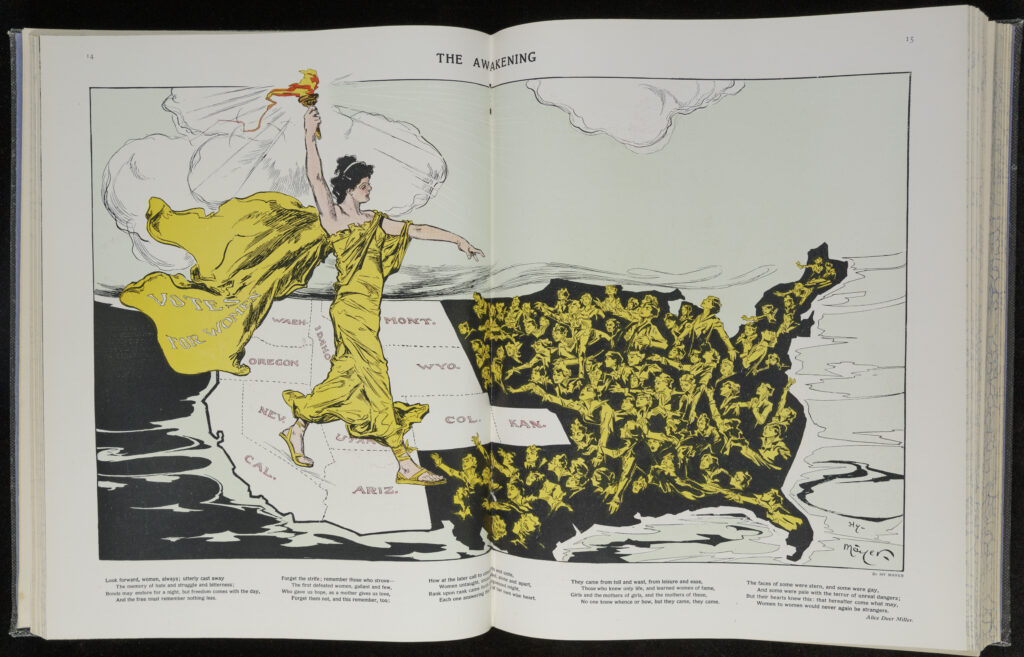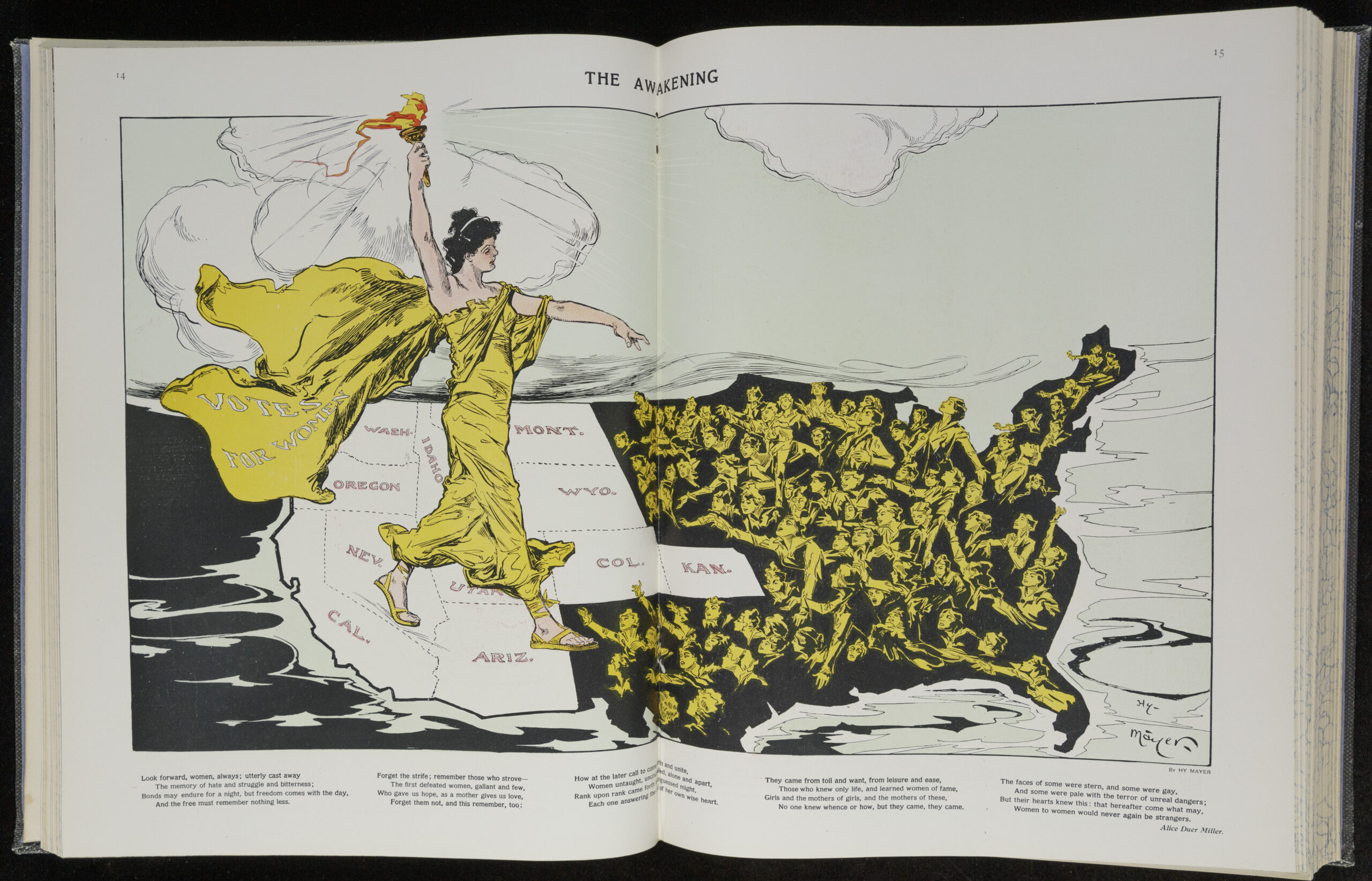Curriculum Connections: African American History, Progressive Era, Women’s History, Women’s Suffrage, Visual Literacy
The political cartoon “The Awakening also appears in the Collection Essay “Decision 1920.”
This lesson explores aspects of the women’s suffrage movement.
The political cartoon below illustrates the spread of women’s suffrage through the individual states, the 1915 Empire Campaign to gain voting rights for women in New York, and the use of visual propaganda in the women’s suffrage movement. You may want to review the Skills Lesson: Bias with students before starting this lesson. The text excerpts bring in the perspective of Black women and the participation and experiences of women of color in the movement.
Process
This lesson is for a teacher-controlled class. If you would like your students to work with the sources independently or in small groups, you can download copies in the Downloads tab.
First, display the image. Give students time to generate and answer questions about it and write notes. After the class has examined the image, display the excerpts and lead students in a discussion about what new information the excerpts provide. Possible questions to use to spark inquiry follow each source. Use these questions and the background material above whenever you think it will encourage students to ask more questions and think more about how to engage with all the sources.
Source 1: Political Cartoon
Click on the image for a high-resolution version that can be displayed for your class.

Potential Initial Questions:
- What map is shown in the political cartoon?
- What are the words on the standing figure’s cape?
- What is she holding?
- What other symbolic figure is she similar to?
- What do you think the standing figure symbolizes?
- Why would the illustrator connect the torch of liberty and votes for women?
- Where is the figure standing on the map?
- How are the states in the West different from the states in the East?
- What might this suggest about the torch the figure is carrying?
- Who are the figures on the eastern portion of the map?
- What are they doing?
- What are their attitudes?
- How does that relate to the message and meaning of this political cartoon?
- Are all American women included in this image?
- How does the title of this political cartoon relate to its content?
- What other interesting details do you see?
- What background knowledge might you need to understand this political cartoon?
- Did this exploration answer the questions you wrote before we began? Did the examination bring up new questions? Where might you be able to get more information or answers to your questions?
Interpretive Questions Based on Background Knowledge
- What was the purpose of this political cartoon?
- Do you think it accurately reflects the situation it is trying to portray? Why or why not?
Background
Long before the Nineteenth Amendment (national suffrage) passed in the United States in 1920, individual states and territories were granting women the right to vote. By 1915, the women’s suffrage movement was united to fight for the vote for women on both a state-by-state basis and through a federal constitutional amendment. The first states and territories that granted women the right to vote were all in the West. Wyoming and Utah territories granted women the vote as far back as 1869 and 1870. Over the next forty years more western territories and states joined them: Washington Territory (1883); Montana Territory (1887); Alaska Territory (1913); Colorado (1893); Idaho (1896); California (1911); Arizona, Kansas, Oregon (1912); and Nevada (1914). In 1913, women in Illinois gained the right to vote for president, but not for other offices.
This political cartoon, published on February 20, 1915, was the centerfold of an issue of Puck magazine guest-edited by New York state suffragists and devoted to “the Empire State Campaign,” an effort to gain the vote for women in New York state. The campaign failed that year, but women in New York finally won the vote in 1917. The map in this cartoon was used in a variety of types of graphics to promote women’s suffrage during the campaign. Puck, published from 1871 to 1918, was a popular political satire and humor magazine known for its illustrations and political cartoons. Henry Mayer (or Hy Mayer), the illustrator of this image, was the chief Puck cartoonist at the time. He had been a political cartoonist for the New York Times and went on to animate for and direct films.
Source 2: Excerpt from The Crisis
The suffrage map [for 1912] shows that six States have equal political rights for women and men, and that a much larger number have granted partial suffrage to women. In all these the colored woman is taking part, not as fully as she will when the question is less of an experiment, not as heartily as she will when her horizon broadens, but she bears her part.
This much, however, is true now: the colored American believes in equal justice to all, regardless of race, color, creed or sex, and longs for the day when the United States shall indeed have a government of the people, for the people and by the people—even including the colored people.
Adella Hunt Logan, “Colored Women as voters,” The Crisis, vol. 4 iss. 5 (September 1912): 242-243. Digitized on Internet Archive by the Kahle/Austin Foundation.
Potential Initial Questions
- Who wrote this excerpt? When was it written? What magazine was it published in? What do you know about the magazine The Crisis? Who was the audience for this magazine?
- How does this excerpt relate to the political cartoon?
- What new information or perspective does this excerpt provide?
- Look at and consider the political cartoon again. Do you look at it differently after reading this excerpt? If so, how?
- What is Logan saying about women and the vote, and African Americans and the vote, in this excerpt?
- Does this excerpt answer any of the questions raised by the cartoon? Does it raise new questions? Where might you be able to get more information or answers to your questions?
Source 3: Excerpt from Colored American Magazine
If white American women, with all their natural and acquired advantages, need the ballot, that right protective of all other rights; if Anglo Saxons have been helped by it—and they have—how much more do Black Americans, male and female, need the strong defense of a vote to help secure them their right to life, liberty and the pursuit of happiness? And neither do the colored citizens of the Republic lag behind in the fundamental duties of the tax-paying and using the elective franchise. The price of their freedom as far as that freedom had progressed, was too dear a price to be treated lightly.
Adella Hunt Logan, “Woman Suffrage,” Colored American Magazine (September 1905) in Public Women, Public Words: A Documentary History of American Feminism, 163-165. Digitized on Internet Archive by the Kahle/Austin Foundation.
Note: You will need a free Internet Archive account to borrow and view this text.
Potential Questions
- Who wrote this excerpt?
- When was it written?
- What magazine was it published in?
- What do you know about Colored American Magazine?
- Who do you think was the audience for this magazine?
- In this excerpt, what is Logan saying about Black women and the vote? About Black people in general and the vote?
- Does this excerpt answer any of your questions?
- Does it raise new questions?
- Where might you be able to get more information or answers to your questions?
Background on Adella Hunt Logan
Adella Hunt Logan, an African American woman, was a leader in the movements for women’s rights and Black rights. The first excerpt is from an article she wrote for an edition of The Crisis devoted to women’s suffrage. The Crisis was a magazine started by W.E.B. Du Bois in 1910 as the official publication of the NAACP. It quickly became a major and well-respected journal covering civil rights and politics, as well as Black life, history, and culture. The excerpt in Source 3 is from the Colored American Magazine, which was published from 1900 to 1909. It covered many of the same issues as The Crisis later did. The Colored American Magazine was known for prominently covering women’s issues.
Extension Activities
- Have students create a suffrage timeline from 1790 to the present noting the dates when different members of the population were able to vote.
- Have students research other women of color who fought for the right to vote. Subjects might include Frances Ellen Watkins Harper, Mabel Ping-Hua Lee, Marie Louise Bottineau Baldwin, and Maria de Guadalupe Evangelina Lopez de Lowther.
- Have students research theories why the western states were the first to grant women the vote.
- Have students research other suffrage maps (URLs can be found below) and create presentations on why they were effective. Some other women’s suffrage maps can be found in the Cornell University Library:
Additional Resources: Political Cartoon
- “Decision 1920.” Newberry Library, Collection Essays.
- “Woman Suffrage in the West:” The National Park Service has an excellent site about suffrage in the West detailing the battle in a variety of western states and including the efforts and importance of women of color in the effort.
- “The 1915 Map That Helped All Women Get the Vote:” An article by Toa Toa Holmes for Atlas Obscura on this image that contains even more background on the use of maps in the fight for women’s suffrage.
Additional Resources: Women of Color and Suffrage
- “African American Women and the Nineteenth Amendment,” National Park Service.
- “Between Two Worlds: Black Women and the Fight for Voting Rights,” National Park Service.
- “Black Women’s 200 Year Fight for the Vote,” American Experience.
- “Black Suffragists,” Women and the American Story.
- The Crisis: Woman’s Suffrage Number.
- “Women of Color and the Fight for Women’s Suffrage,” California Commission on the Status of Women and Girls.
- “Meet the Brave but Overlooked Women of Color Who Fought for the Vote,” New York Times, August 19, 2020.
Words to Know
suffrage | the right to vote in an election; franchise
Download copies of the lesson and its sources below.



